I recently received this message from Patti Stouter, who has been a long time advocate and experimenter with earthbags and other natural technologies, especially as a means for surviving earthquakes and other calamities:
I am beginning a test shelter project of straw wattle that may be helpful in both Ukraine and Turkey, so this report of proven performance will be helpful to aid workers.
Earthbag and mesh-enclosed light straw clay have performed well in a Haitian agriculture school now for more than five years. The Haiti Christian Development Project school is in the country outside Gonaives where the climate is hot and somewhat dry, with 28 inches of rain per year. Local builders prize earthbag homes for their cool interiors and potential to resist earthquakes.
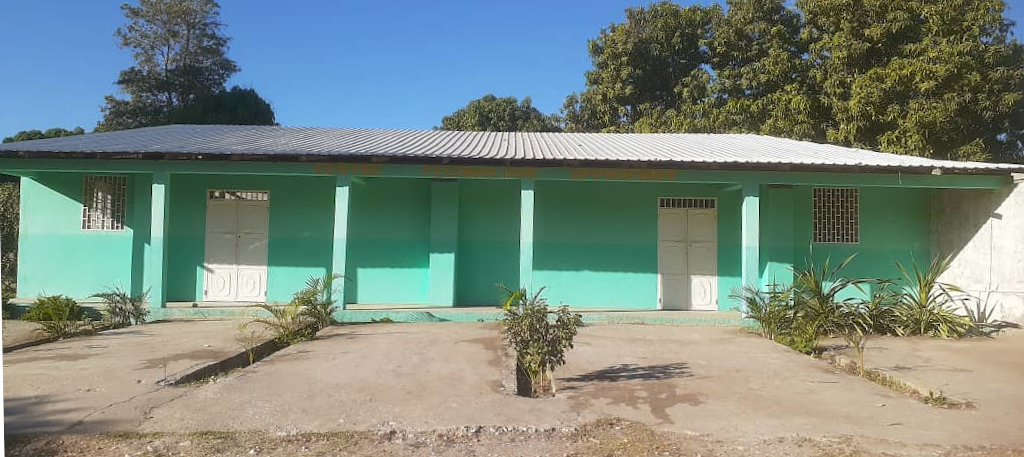 One earthbag building near the northern coast needed repairs to its bond beam after a quake several years ago, but its earthbag walls were undamaged. Reinforcing steel in the bond beam may have been placed too close to the wall surface.
One earthbag building near the northern coast needed repairs to its bond beam after a quake several years ago, but its earthbag walls were undamaged. Reinforcing steel in the bond beam may have been placed too close to the wall surface.
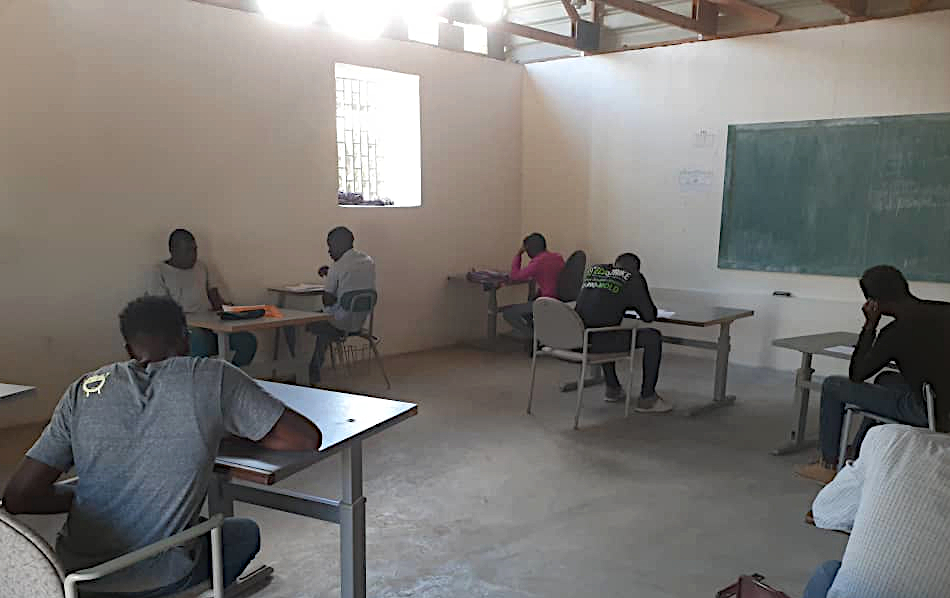 Earthbag is a heavy material, requiring labor to build. Heavy walls undergo extreme forces in earthquakes, often concentrating at the wall tops. Lighter walls go up quicker and undergo less force in quakes. Lighter walls can be safer in earthquakes with less exacting detailing.
Earthbag is a heavy material, requiring labor to build. Heavy walls undergo extreme forces in earthquakes, often concentrating at the wall tops. Lighter walls go up quicker and undergo less force in quakes. Lighter walls can be safer in earthquakes with less exacting detailing.
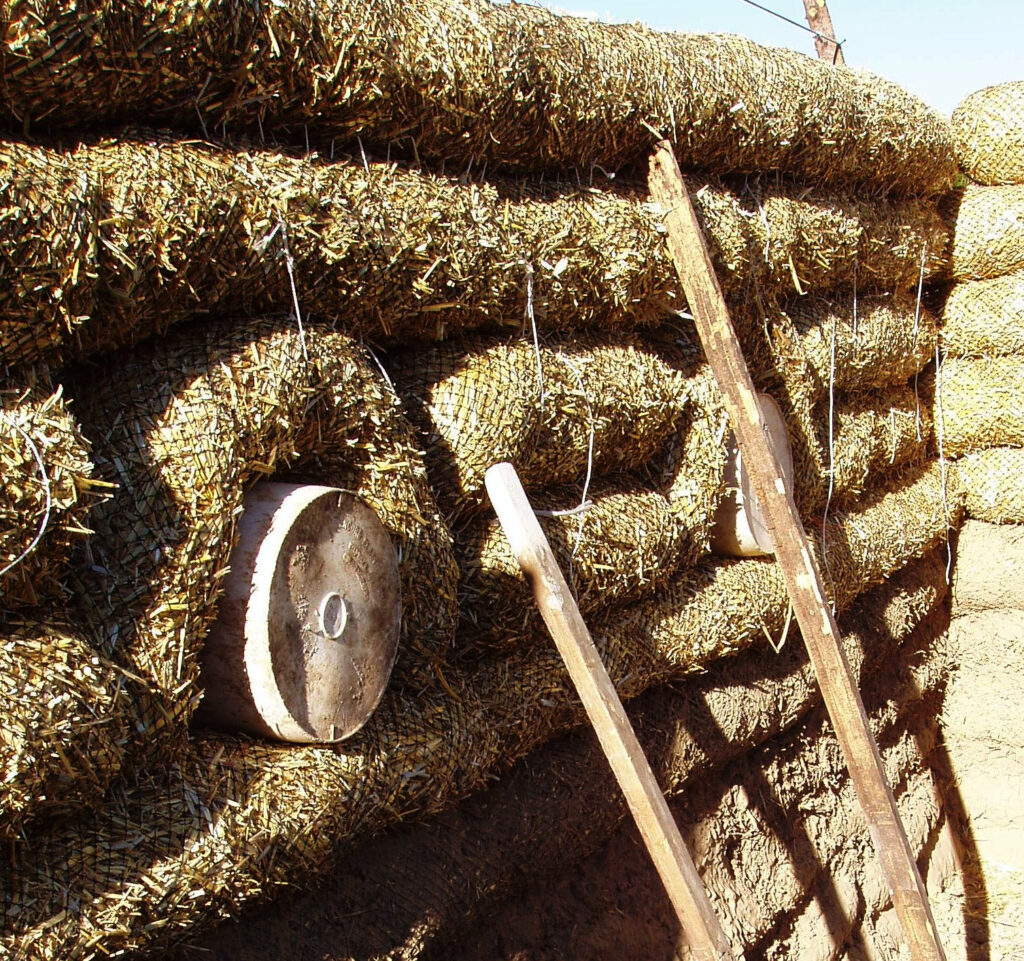 A special version of LSC (light straw clay) was chosen by HCDP for a dormitory both for it’s light weight and to shorten construction time. Mesh tubing commonly seen in loosely filled erosion control wattles was repurposed for walls. LSC is usually built as infill between wood framing, applied wet into a moveable form that holds it together until it stiffens.
A special version of LSC (light straw clay) was chosen by HCDP for a dormitory both for it’s light weight and to shorten construction time. Mesh tubing commonly seen in loosely filled erosion control wattles was repurposed for walls. LSC is usually built as infill between wood framing, applied wet into a moveable form that holds it together until it stiffens. When logs made by firmly stuffing straw into stiff mesh tubing are tied or sewed on both sides to unite layers, the mesh acts as a form, adds reinforcement, and makes it difficult for thieves or rodents to dig in. After soaking the straw with clay, earthen plaster levels the surfaces.
When logs made by firmly stuffing straw into stiff mesh tubing are tied or sewed on both sides to unite layers, the mesh acts as a form, adds reinforcement, and makes it difficult for thieves or rodents to dig in. After soaking the straw with clay, earthen plaster levels the surfaces.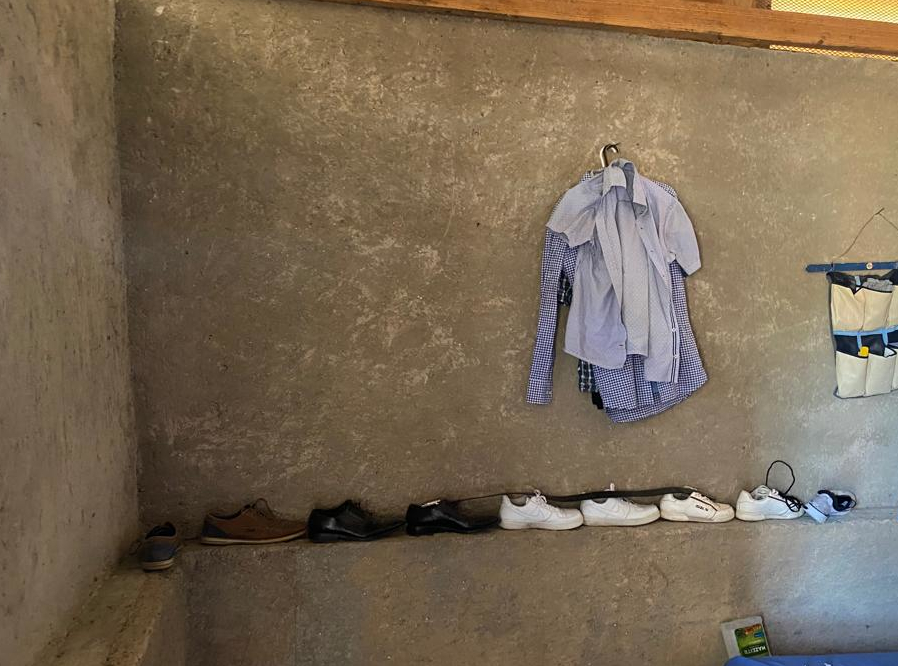 Wattle walls become stronger with stronger clay, when more clay is worked in and when clay penetrates more deeply into the logs. But to hold up roofs sized for houses or larger buildings, BuildSimple.org recommends a strongly interconnected framework of poles worked through the mesh.
Wattle walls become stronger with stronger clay, when more clay is worked in and when clay penetrates more deeply into the logs. But to hold up roofs sized for houses or larger buildings, BuildSimple.org recommends a strongly interconnected framework of poles worked through the mesh.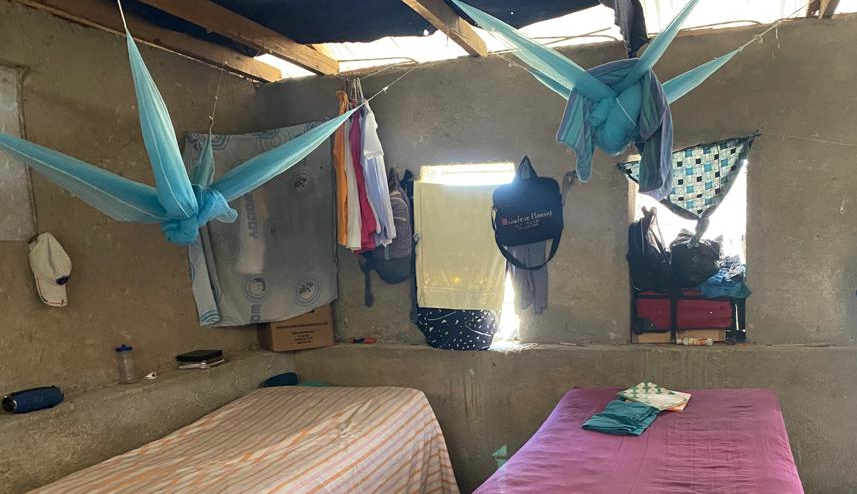 Haitian builders hammered rebars into earthbag base walls for their dormitory. Each course of dry straw log was impaled on the rebar.
Haitian builders hammered rebars into earthbag base walls for their dormitory. Each course of dry straw log was impaled on the rebar.
Clay and straw materials are best finished with a breathable plaster of lime or earth. Because Haiti has no hydraulic lime and shipping (even in better conditions some years ago) was difficult, the builders used cement stucco as a wall finish. Because of the dry climate and good roof maintenance, no repairs have been needed to these inexpensive and lightly insulated walls.


Thanks for such a wonderful site.
I am just not sure of your definition of Wattle. We are in South Africa and here there is plenty of Wattle and daub or wattle gabion filled with rocks and then clay straw plastered. Black Wattle trees are on the invader list and very common so a very strong wood to use in such a way. So reading your piece above makes me wonder where the wattle fits in in this method?
Wattle was first and primarily wattle and daub. But, in the US (and Europe) logs of fiber-filled material began to be used to hold eroding slopes. First these were bundles of sticks staked in long lines along a slope- does that sound a little like vernacular wattle and daub? Over the past twenty years they became machine assembled ‘erosion control wattles’ of straw stuffed into long tubes- more machine work meant less of our high labor costs. In Europe they may be called fiber rolls. See a diagram here: File: https://commons.wikimedia.org/wiki/File:Fiber_roll_EPA.jpg
My method used the strength of the plastic tubing to prevent thieves breaking in too easily and to transfer more stresses around the walls so that hard impacts or shaking can’t pull the layered fibers apart. And instead of dabbing daub (mix of clay and fiber) into the coarse fibers/ branches I pour liquid clay to soak the logs filled with dry straw. After these have firmed up I dab a daub-like mix into the nooks to level and strengthen the layers.
Patti Stouter
Trying to find out if the mesh tubes are filled with straw and then the clay slip added or is the straw and clay mixed and then put in the tube? And what are the tube called, possible places to find?
thanks, Shirley
I’m pretty sure that the straw and clay are mixed before they are placed in the tubing. There are various sources for such mesh tubing listed at https://earthbagbuilding.com/resources.htm#supplies lower down on the page.
I think I used
https://volmcompanies.com/products/erosion-control/straw-wattle.
The Canada bag supplies was for the lighter-weight bigger diameter mesh tubes to fill with earth for hyper-adobe. It’s safer to ask for photos or a sample.
Sorry to leave this un answered for so long. Straw mixed with clay is sticky and slow to process, and makes very heavy filled tubes that soak workers in clay. The benefit of what I call straw wattle is that the straw is easy to stuff into the mesh tubes, and the tubes can be sewn together in a fairly clean process. Clay is soaked until it becomes liquid and can be poured onto the straw tubes. I used a watering can with a pointed lip and stuck it into the nooks between courses, and it soaked through the straw pretty well.
The mesh tubes I used are called straw wattle tubing for erosion control.
Interested in the clay straw slip in the tubing. Is there a site that talks about it? Mixture amounts, how to pack, where to find the tubing?
Patti Stouter is the best source of information about this. Her website is https://buildsimple.org/
See also https://naturalbuildingblog.com/energy-globe-award-haiti-2014/#more-10370
Sorry, Shirley, I haven’t posted anything new about straw wattle in a while and may need to update my online files.
There’s a lot online about SLC- light straw clay, that may be helpful. The only difference with straw wattle is it is held in place in mesh tubing instead of inside a moveable form.
Clay soil must be soaked to make a liquid, and dipping a hand or spoon in it should act more like cream or yogurt than like milk. It also should make a sticky mass when you soak some straw in it, not just wet. If your soil does not contain enough clay to make it sticky like this, you can concentrate it by soaking a 5 gallon bucket of it, stirring it well, letting it sit for 5 minutes (sand falls to the bottom in a minute or two and the non-sticky silt starts to settle too), then gently pouring off the liquid part. Try with the concentrate that you poured off and see if it will make the straw sticky.
Straw wattle often needs some inserted poles or other structure to help hold up the roof, and if these are provided you don’t need to reach a certain stickyness and strength to resist crushing that depends on the type and quality of the clay in your soil.
Here’s one source of tubing:
https://wattlenetting.com/?gad_source=1&gclid=EAIaIQobChMIx9aC5c7KhwMViTUIBR34HCHREAMYASAAEgISfvD_BwE
It should be called 8″ wide laid flat- wider will be too costly to fill with straw.
I have several pdfs online. Go to https://BuildSimple.org/Resources
Look at the 2nd section under Resources for Disaster Aid.
Please let me know if you build anything.
Hello,
I just found your site while searching for earthbag homes. We just bought a small finca in Humacao, Puerto Rico and plan to build an earthbag home and start an educational and agricultural nonprofit.
Our climate is humid, warm, and prone to tropical storms and hurricanes. We want to build a 2-story structure to take advantage of the view. Do you think earthbag is the best method for us?
Thank you,
Maria Gonzalez
Yes, it may well be the best fit for you. There is a similar organization in Puerto Rico, https://www.plenitudpr.org/ , that utilizes and even teaches about earthbag building. See also https://naturalbuildingblog.com/earthbag-dome-at-plentitud-puerto-rico/
Yes, I agree. In a very humid climate straw-clay walls work well in the interior, as long as you have enough structural earthbag and/ or other strong materials to hold up the roof. Straw-clay can be covered with lime plaster to resist heavy rains, but it is critical that the top of the wall be well protected with a large roof overhang. My friends in Haiti used portland cement based stucco over straw wattle and it has survived well, but they are in northern Haiti where it is very dry.
I wouldn’t use straw-clay for the base of the wall- keep it above the splashback level (look at local housing to see how far up the mud usually splatters). Use a stabilized earth or a stone foundation up to the level that the walls may be often soaked by blowing or splattering rain.